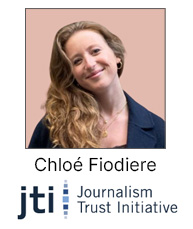
 With the rise of misinformation in digital media, it can be challenging to identify trusted content and news sources.
With the rise of misinformation in digital media, it can be challenging to identify trusted content and news sources.
The Journalism Trust Initiative (JTI) was launched by Reporters Without Borders (RSF) to help quality media outlets demonstrate their commitment to creating transparent, ethical journalism. AAM is an official certifier for the JTI standard – a set of transparency standards for media outlets’ production of trustworthy news and information.
We recently sat down with Chloé Fiodiere, development manager for JTI, who is overseeing global implementation of the program, including a focus on Canadian media. Chloé shares more about the initiative, how media outlets can get started and the benefits for Canadian media.
AAM: How did the Journalism Trust Initiative get started?
Chloé Fiodiere: RSF observed that the spread of misinformation and disinformation was diminishing trust in all journalism, leading to decreases in visibility, audience and revenue for legitimate media. We wanted to create a framework to help trusted media outlets stand out in the marketplace for their commitment to transparency and creating ethical journalism. The JTI Standard was developed by RSF in collaboration with 130 experts and organizations representing journalists, editors and members of the tech and advertising industries.
AAM: What is the certification process for media outlets?
Chloé Fiodiere: The JTI Standard involves a three-step process. The first step is a self-assessment to help media outlets compare their editorial practices and processes to the JTI Standard. The second step involves disclosing the self-assessment to the media outlet’s partners and audience by publishing a Transparency Report in the JTI app. The third step, which is required to achieve certification, is for the media outlet to participate in an independent, third-party audit to certify the Transparency Report.
AAM: Why are third-party audits an important part of JTI?
Chloé Fiodiere: A third-party audit ensures that the media outlet’s declarations in the Transparency Report match its day-to-day newsroom operations. Having the report validated by an impartial third party lends greater credibility to the media outlet and elevates trust in the marketplace.
AAM: What types of media outlets can be certified?
Chloé Fiodiere: JTI certification is open to all forms of media including print, TV, radio and digital. The JTI Standard is a global program open to participants from around the world.
AAM: Why should Canadian media participate?
Chloé Fiodiere: Our goal is for the JTI Standard to help quality media outlets become easily recognized by algorithms and indexed by technology platforms. We also work with organizations such as the World Federation of Advertisers to encourage advertisers to invest in certified media outlets. The certification provides supporting documentation that can help media outlets receive financing from private and government organizations.
AAM: What makes JTI unique from other initiatives focused on fighting misinformation?
Chloé Fiodiere: The JTI Standard focuses on transparency and the production methods for creating content, not on the content itself. Also, JTI is an international standard, so these criteria can be applied to any media outlet in the world.
AAM: What are your plans for bringing JTI to Canada?
Chloé Fiodiere: There are currently 400 media outlets from 70 countries participating in the program. Scaling the program to include as many media outlets as possible will strengthen the program and help all participants. Having Canadian media join JTI would be a significant step toward advancing the program globally.
AAM: How can media outlets learn more about JTI?
Chloé Fiodiere: Media outlets can visit our website to create an account and discover the first step in the process. For questions, contact us at jti@rsf.org.








